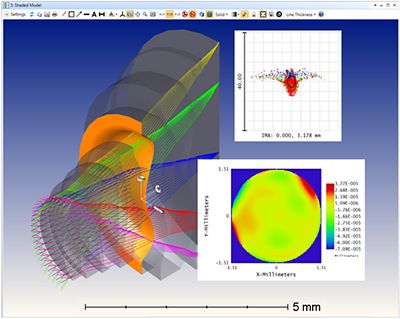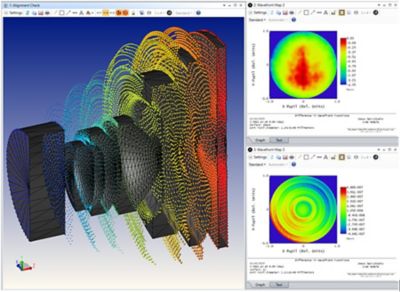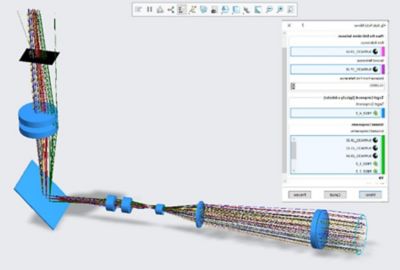-
United States -
United Kingdom -
India -
France -
Deutschland -
Italia -
日本 -
대한민국 -
中国 -
台灣
-
-
產品系列
查看所有產品Ansys致力於為當今的學生打下成功的基礎,通過向學生提供免費的模擬工程軟體。
-
ANSYS BLOG
February 8, 2023
Take Augmented Reality and Automotive Designs to the Next Level with the Latest Ansys Zemax Updates
Current trends in augmented reality (AR), automotive, and other high-tech markets and industries are pushing the optics community to design new, innovative products with enhanced performance faster than ever before.
Simulation is critical in optical design because it enables you to accurately model your designs and performance — but that’s not all it does. Ansys Zemax OpticStudio enables you to simulate, optimize, and tolerance your optical designs, while Ansys Zemax OpticsBuilder unites optical and mechanical teams to collaborate on the design of optical products and systems.
Now, with the latest updates in Ansys 2023 R1, both platforms introduce new capabilities that enable you to optimize your designs and performance to greater levels. With upgraded tools and features, you can design and build systems that produce sharper, more accurate images for applications from AR wearables to automotive head-up displays (HUDs).
Create Optics that Stun with Ansys 2023 R1
As technology rapidly develops in consumer electronics, advanced driver assistance systems (ADAS), and other markets, optical design software is enabling companies to deliver cutting-edge innovations that meet increasing consumer demands and expectations. Whatever the application or optical design need, OpticStudio and OpticsBuilder deliver end-to-end solutions, including robust modeling, predictively accurate simulation, and fully customizable analyses.
Today, the optics community has more solutions to add to its tool kit with the latest release of OpticStudio and OpticsBuilder, which includes the following improvements and features available in the noted product editions:
- Ansys Lumerical 2D RCWA Dynamic Link Library (DLL) (OpticStudio: Premium and Enterprise editions)
Experience easier integration to Ansys Lumerical FDTD by dynamically linking OpticStudio to the Lumerical rigorous coupled-wave analysis (RCWA) solver for calculating diffraction efficiency (when Lumerical is installed on the same computer). With this feature, you can simulate and optimize complex 2D gratings used in advanced AR and HUD systems.
- Composite Surface Capability (OpticStudio: all editions)
Easily create and tolerance complex surface geometries in sequential mode, including direct tolerancing of irregularities on sag-based and stacked composite surfaces without requiring workarounds by utilizing the latest composite surface capabilities in OpticStudio. With this feature, you can add multiple sag profiles to achieve an optical surface with a complex new sag distribution as desired. Similarly, if you want to add several types of sag distributions to one surface, you can add multiple surfaces as a composite stack.

With the latest Ansys Zemax product release, all editions of Ansys Zemax OpticStudio include enhanced composite surface capabilities.
- Non-Sequential Single Ray Tracing (OpticStudio: all editions)
With this tool, you can analyze and visualize single rays in non-sequential mode without affecting your original system. As a result, you can design advanced AR optical systems with a better understanding of ray behavior in exit pupil expanders and other complex imaging systems. Non-sequential ray tracing enables light rays to propagate through optical components in any order, which allows for ray splitting and scattering. With ray splitting, fewer rays are traced, which speeds up computations.
- Enhanced Structural, Thermal Analysis, and Results (STAR) Capabilities (OpticStudio: Enterprise edition)
Through new and improved STAR capabilities, including active control of rigid body motion (RBM), you can enable or disable RBM impacts independent of surface deformation effects for more granular control during analysis. Using this function, you can visualize optical performance changes from surface deformations and RBMs separately, which helps clarify the location of parts in your design. Additional STAR updates include improved speed for optical designs that require ray aiming (such as wide-angle camera lenses) and closer trimming of voxels to aperture in the STAR System Viewer. Closer voxel trimming provides a more realistic view of the distribution of temperature and refractive indices in an optical component after thermal finite element analysis (FEA) data is applied.

OpticStudio now offers active rigid body motion (RBM) options that provide engineers and designers with more granular control during analysis.
- Equation-Driven Import for Common Surface Types (OpticsBuilder)
In OpticsBuilder, you now have the option to use equation-driven import for common surface types. This means that you can expose the equations that define the optical geometry and tie those equations to the part file of your design, enabling you to store optical parts in a product data manager (PDM) and recall the equations later. Equation-driven surfaces also mean better accuracy of your computer-aided designs (CAD) which enable you to create more complex mechanical edges on your optical parts.
- Fold Mirror Tool Fixes (OpticsBuilder)
Fold mirrors are often used in optomechanical design to allow optical designs to fit in tight mechanical space constraints by enabling the user to fold along the optical path without affecting the focal length of the design. The legacy fold mirror simulation tool in OpticsBuilder has been overhauled and all known issues have been addressed. The tool is now robust and ready for future additional functionality.

The legacy fold mirror tool in Ansys Zemax OpticsBuilder has been improved and now offers greater functionality.
See For Yourself
OpticStudio and OpticsBuilder enable you to perform detailed and comprehensive analysis of the optical and opto-mechanical performance of your system when creating high-fidelity designs for AR, automotive, and high-tech applications. OpticStudio’s intuitive user interface includes easy-to-learn tools and wizards that enable efficient simulation and design of any optical system, while OpticsBuilder empowers you to design mechanical structures around optical components in minutes using exact component data.
The latest release continues the Ansys Zemax tradition of meeting customers’ needs for state-of-the-art optical design and workflow optimization software.
To learn more, view our on-demand webinar Ansys 2023 R1: Ansys Zemax OpticStudio and OpticsBuilder What’s New.










